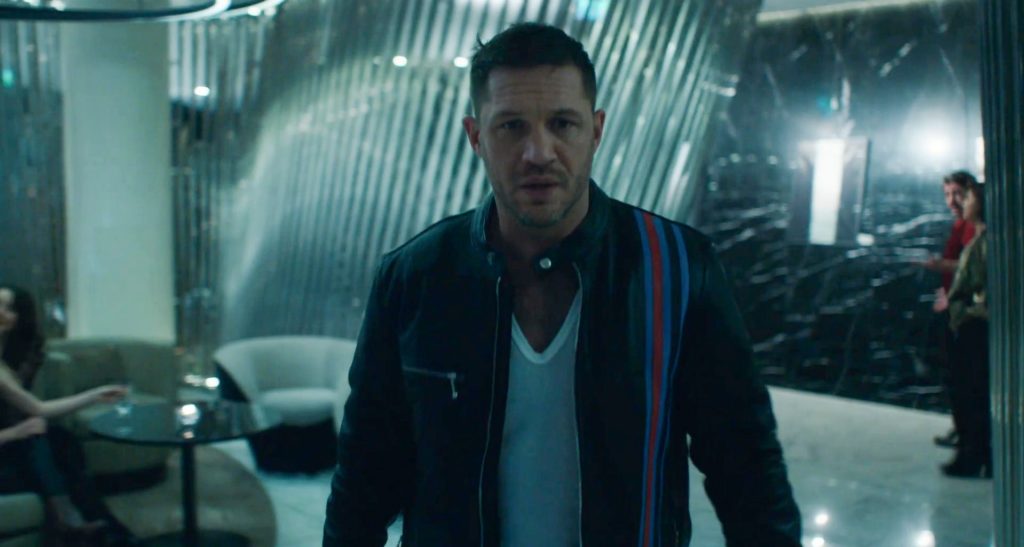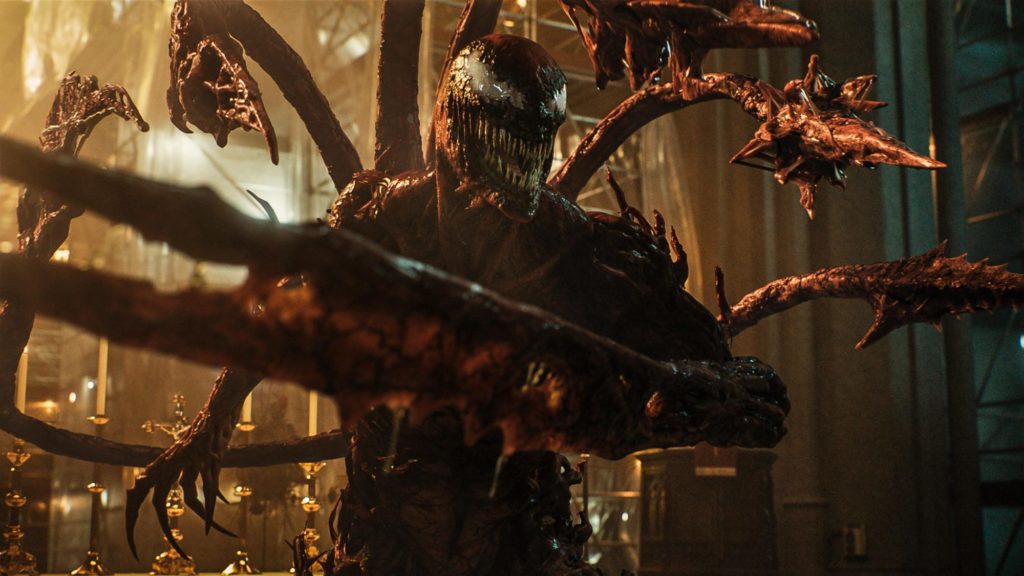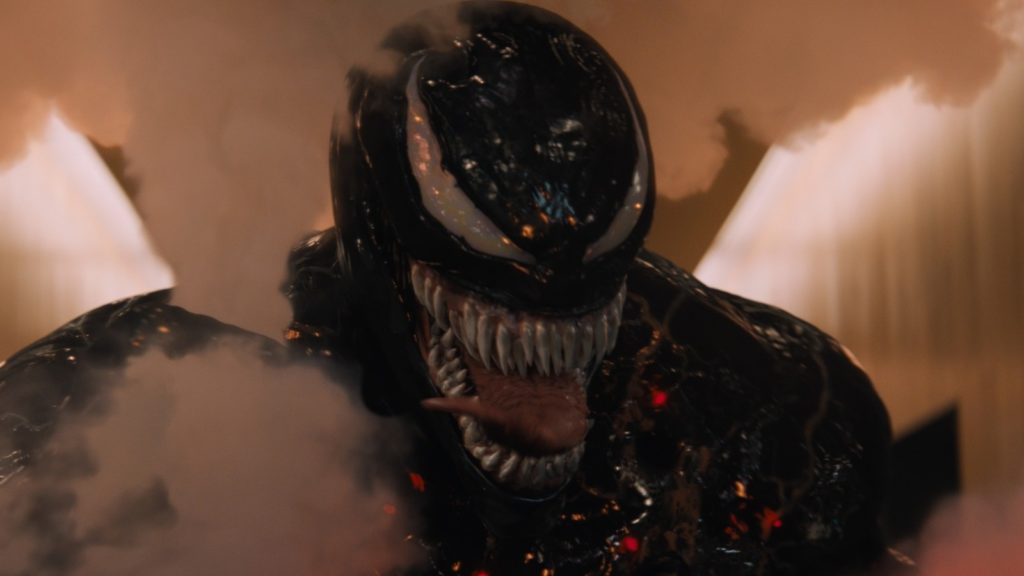Tom Hardy Confonts Woody Harrelson in Dumb, Scattershot, Spider-Man-Adjacent Sequel
DIRECTED BY ANDY SERKIS/2021

I’m old enough to have bought the first appearance of Venom. It was 1988, and Marvel’s flagship comic book series, The Amazing Spider-Man, was flying high. On the last page of issue #299, artist Todd McFarlane cut loose with one of the all-time most striking introductory panels, fully revealing Spidey’s new symbiote villain (the “symbiote” being a cognizant, malevolent being that requires a symbiotic attachment to a willing human host) in all his frightening glory. Needless to say, the ooey-gooey baddie stuck around. In fact, he stuck around to the point of transcending “re-occurring villain” status, eventually netting his own high-profile feature film in 2018.
As was the case in the comics so many years ago, the ongoing fascination with Venom resulted in a wave of spin-off symbiote characters, the first of which was the blood-red psychopath, Carnage. Debuting in 1992, Carnage, as hosted by serial killer Cletus Kasady, hails terminally from a cultural moment when such murderers and slashers were all the rage. Obviously, Carnage- sinister, spindly, and completely without conscience- was to be Marvel’s very own Freddy Krueger, or some such equivalent. The fact that such a character was hosted by my favorite series starring my favorite superhero was a souring, ongoing blow. (Though McFarlane had long since departed, writer David Michelinie carried on). By the time the wearyingly chaotic “Maximum Carnage” event occurred, I was sadly checking out. (It took the notorious and far more interminable “Clone Saga”, just a few years later, to get me to completely throw in the towel with Spidey comics… for a while, anyway).
All that to say that, like fellow old-school fan and Spider-Man 1-3 director Sam Raimi (who was strong-armed into including Venom in his 2007 final installment), I guess I tend to prefer my Spider-Man foes to be of the classic green and purple variety. Venom, as intriguing as he initially was, soured quickly into a too-popular anti-hero. He was dubbed the “Lethal Protector” (groan). My rationale was that any Venom movie would inevitably fall more in line with those virtually unreadable comics than anything that made the character truly interesting.
So, imagine my surprise when 2018’s Venom proved not only to be a big hit, but also a pretty satisfying (if non-sensical) movie. Director Ruben “no relation to Max” Fleischer managed, against the significant odds inherent in any association with the voluminous source material, managed to strike a tone both appropriately ominous but also bringing a newfound sense of humor to the property.

Tom Hardy, well established as a great actor of tortured psyche and ruggedness, was put to solid use as flailing San Francisco investigative journalist Eddie Brock. In that first film, Eddie finds himself conjoined with the smart-mouthed black symbiote Venom just as his life is falling apart. Having lost his job and his fiancé, district attorney Anne Weying (who became “She-Venom” in the comics and played by Michelle Williams), Eddie quickly finds himself embroiled in a symbiote exploitation scheme being hatched by a deranged enterprising billionaire. All that works itself out by the end, with Eddie re-committing himself to journalism. His first big story? Uncovering the secrets of imprisoned serial murderer Cletus Kasady (Woody Harrelson). That’s where 2018’s Venom ends.
By the first fifteen minutes of the new and considerably lesser sequel, Venom: Let There be Carnage, he’s done that. Thanks to Eddie’s intrepid front-page reporting, Kasady is sentenced to the death penalty. But before the lethal injection takes place, Kasady, in a tense final prison visit from Eddie, ends up with a fragment of the malleable alien Venom. One thing leads to another, and the crimson PG-13 Carnage is born.
Not that Carnage hasn’t always been a PG-13 character… though I suspect that the necessary approval of the now-defunct Comics Code Authority was part of why the bloodthirsty homicidal maniac never seemed a great fit in the typically rousing pages of The Amazing Spider-Man. But, in our current age of R-rated Deadpool movies and James Gunn’s The Suicide Squad, a notably tempered Carnage just feels neutered and wrong. In any case, the whole thing is likely a no-win exercise in franchise moviemaking, as a viscerally gory Let There be Carnage would’ve probably been just a different version of the bad movie that it is. But at least that would’ve been truer to itself.

As it is, we are told but never effectively shown how ruthless Kasady is. Rather, director Andy Serkis (that’s right, Gollum himself) relies entirely on Harrelson’s deranged wild-eyed grins to sell his demonic instability. The threat level feels entirely phoned in, courtesy of a horrendous screenplay that’s never about anything other than said threat level. It’s strange that Tom Hardy has a shared story credit (with Fifty Shades of Grey screenwriter Kelly Marcel, who also nets full screenplay credit for this, Lord help her) for this movie where his title character is reduced to a glorified supporting character, second banana to his own CGI chatterbox partner in crime. The dialogue is nothing but tired comedy beats (“Awkward!”) and failed shock swearing. No sentence seems to run longer than six words.
Much time is spent on Eddie and the Venom symbiote bickering in their apartment over whether eating “bad people” should be okay or not. That debate is as in-depth as their relationship ever gets in this notably short film. (Venom: Let There be Carnage clocks in at a highly suspect ninety minutes, with credits. At least it’s not long). Though Venom and other Spidey characters that remain licensed to Sony (the upcoming Morbius, for example) are said not to be part of the almighty Marvel Cinematic Universe, even though the hub of their wheel- Tom Holland’s Spider-Man– very much is. Considering, though, that Marvel proper has never made a film as disastrously bad as this, Sony ought to be reconsidering its tight clutch in those reigns.
In keeping with the contemporary trend in these sorts of movies, fans will want to stay through the first part of the credits. There, they will be treated to the most head-scratchingly clunky bonus scene of them all. As awful as this tag is, it nonetheless remains the only thing worth talking about afterwards. The rest of Let There be Carnage is a sad embarrassment to all parties involved. (This includes the great Michelle Williams, who’s even more wasted here than she was in the first film. And let’s not forget three-time Oscar winning cinematographer Robert Richardson, who inexplicably lit the movie like a cheap, garish haunted house attraction). It embraces a long-abandoned splash page aesthetic, valuing cool poses and wicked-sounding dialogue far above all else.

Never has Woody Harrelson been so firmly outed as a “working actor”, content to appear in whatever pays well. His performance is a warmed-over version of his truly controversial Natural Born Killers role- something that the thirteen-year-olds in the targeted demographic will have zero knowledge of. That film (also shot by Richardson) is also a mess, albeit one that is not forgotten. By contrast, I’m struggling to recall details of Let There be Carnage after only having sat through it the night before.
Given my own stated aversions to the Carnage character in general, it’s likely that any Venom follow-up featuring him would not be my cup of tea. The shock, then, is just how disposable, how generic, how hollow and adolescent this mess of pixels and wasted talent truly is. This Carnage is anything but maximum… It’s as though Sony top brass shrugged and said, “Let there be garbage”.

